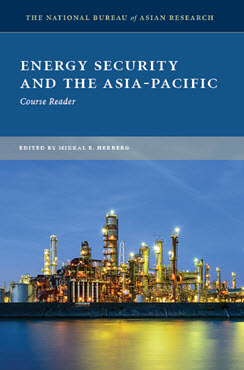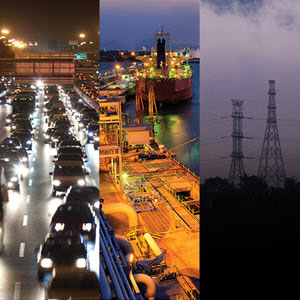NBR Books
Energy Security and the Asia-Pacific: Course Reader
The Asia-Pacific is now the center of growth in global energy and commodity demand. Driven by rapid and sustained economic development across the region, this shift has triggered important changes in global energy flows. It has also posed major new energy security challenges for Asian governments and fundamentally altered the geopolitics of global energy. This special collection of essays from leading experts, selected from previous NBR publications, provides students with a strong foundation for understanding the trends and challenges shaping the energy security outlook for the Asia-Pacific and the world.
Table of Contents
OVERVIEW
Energy Security and the Asia-Pacific
Mikkal E. Herberg
GEOPOLITICS AND ENERGY SECURITY
The Rise of Energy and Resource Nationalism in Asia
Mikkal E. Herberg
Asia’s New Role in Global Energy Security
John V. Mitchell
The New Geography of Asian LNG
Nikos Tsafos
The Implications of Expanded Nuclear Energy in Asia
Charles D. Ferguson
Oil and Gas Pipelines: Prospects and Problems
Paul Stevens
COUNTRY STUDIES
“Going Out”: China’s Pursuit of Natural Resources and Implications for the PRC’s Grand Strategy
Aaron L. Friedberg
The Roots of Chinese Oil Investment Abroad
Trevor Houser
China’s Coming Decade of Natural Gas
Damien Ma
Japan’s Response to Its New Energy Security Challenges
Tsutomu Toichi
Asia’s Post-Fukushima Market for Liquefied Natural Gas: A Special Focus on Japan
Tomoko Hosoe
The Geopolitics of Northeast Asia’s Pipeline Development
Shoichi Itoh
Russian LNG Exports to Asia: Current Status and Future Prospects
Michael Bradshaw
REGIONAL STUDIES
Energy Nationalism Goes to Sea in Asia
Gabe Collins and Andrew S. Erickson
Prospects for India’s Energy and Geopolitical Roles in the Middle East
Sumit Ganguly and Manjeet S. Pardesi
The Geopolitics of the Myanmar-China Oil and Gas Pipelines
Bo Kong
U.S. IMPLICATIONS
China’s Search for Energy Security: Implications for U.S. Policy
Kenneth Lieberthal and Mikkal E. Herberg
How the Shale Revolution Will Transform U.S. Policy
Amy Myers Jaffe
The U.S.-Canada Energy Relationship and the Growing Role for Asia
James Slutz
Introduction
Over the past fifteen years, Asia has increasingly become “ground zero” for growth in global energy and commodity demand, as rapid and sustained economic development has driven the need for more energy. Demand has been centered in China but extends across developing Asia and India, with a pace and scale that has been stunning. Having accounted for only 28% of base-load global energy consumption in 2000, the region accounted for 76% of the entire increase in world energy demand over 2000–2013. During that period, while energy demand worldwide grew by 36%, China’s energy demand tripled, India’s doubled, and Asia’s as a whole doubled. China and India together accounted for two-thirds of global energy demand growth, and Chinese demand growth was equivalent to creating the energy demand of two Latin Americas. With respect to oil specifically, while Asia accounted for just 28% of total world oil demand in 2000, it accounted for 66% of demand growth in 2000–2013. China alone accounted for 42% of growth, as Chinese oil demand quadrupled from 1990 to 2012. Over that period, oil consumption in Asia overall more than doubled. [1]
This profound shift in energy consumption patterns has triggered huge changes in global energy flows, posed major new energy policy and security challenges for Asian governments, and fundamentally altered the geopolitics of global energy. This course reader collects essays from the National Bureau of Asian Research’s Energy Security Program, Strategic Asia Program, and Asia Policy journal that address a wide range of these changes and the resulting challenges for Asia.
Changing Energy Security Dynamics in Asia
The changes in global energy consumption have reshaped the underlying context for energy security dynamics in Asia today. In terms of geopolitics, the fulcrum of world oil trade has shifted decisively onto a Middle East–Asia axis. Asia now relies on imported oil for nearly three-quarters of its oil needs, with two-thirds of those imports coming from the Middle East. Three-quarters of Persian Gulf oil exports now go to Asia. With Asia, and China in particular, emerging as the future market for the Gulf oil producers, a new “energy Silk Road” is in the making. China is dependent on imports for 60% of its oil supply, India for 75%, and the Association of Southeast Asian Nations (ASEAN) for 35%. Japan and South Korea remain essentially 100% dependent on imports of oil, natural gas, and coal supplies. Further, 80% of Asia’s oil imports are transported through the congested and increasingly contested sea lanes of the Indian Ocean, Malacca Strait, and South and East China Seas. Asia’s natural gas supplies also are progressively imported either by sea or by long-distance, overland pipelines from Central Asia and Russia.
Hence, energy security has decisively moved up the strategic and economic agendas of all the major Asian powers. Within the region, angst over high prices and future access to secure energy supplies has fueled a highly competitive, zero-sum mercantilist atmosphere that has added to regional strategic rivalries. China, Japan, South Korea, and India are all expanding their energy diplomacy in the Middle East, Central Asia, Russia, Africa, and Latin America in an effort to secure future supplies and transport routes. Moreover, competition for control of the sea lanes through the South and East China Seas is contributing to a regional naval arms race, and the potential for uncovering new oil and gas supplies in these seas is intensifying increasingly bitter and dangerous competing maritime territorial claims.
Asia is also scrambling to mobilize sufficient energy supplies to continue supporting economic growth while at the same time trying to move toward a cleaner, more sustainable energy mix. For China, India, and much of Southeast Asia, readily available and relatively cheap coal has been the fastest-growing fuel source to meet rising electricity demand, but with disastrous environmental consequences. Although China’s extreme air pollution problems are the most notorious, coal-derived air pollution problems are extreme across the region, including in India and Southeast Asia.
As a result, countries throughout the region are seeking to expand the use of natural gas and liquefied natural gas (LNG) for both energy security and environmental reasons. China is planning to increase its natural gas use fourfold from 2010 to 2020. But LNG prices in Asia are punishingly high, and gas via long-distance pipelines from Central Asia, and in the future from Russia, is also very expensive. Nuclear energy has been high on the region’s agenda for the future as a clean source of base-load electricity but now faces serious new challenges in parts of Asia in the wake of the Fukushima disaster.
Recent Developments Affecting Energy Security in Asia
The essays collected in this reader analyze the fundamental themes, dynamics, and challenges emerging in this changing Asian and global energy landscape over a period of nearly a decade. Although within the broad context of rising energy demand many of the same anxieties over energy security persist, a number of recent developments are also powerfully influencing the energy security context in Asia and globally. Among the most important is the Arab Spring, which has unleashed enormous new political and economic instability in the Middle East and North Africa. Uprisings in Libya, Syria, Iraq, Egypt, and Yemen each had an impact on oil and LNG exports and introduced uncertainties into both the near-term and the long-term outlook for global oil and LNG supply. For Asia, given its growing dependence on Persian Gulf supplies, this trend is deeply worrisome. Although such instability has not yet directly affected the major Gulf oil producers, most importantly Saudi Arabia, supply outages, especially from Libya, have already added pressure for higher global oil prices. Growing instability in Iraq is also a critical long-term concern in view of the potential fracturing of Iraq as a result of the country’s decline into violent Shia-Sunni sectarian divisions. Iraq has been expected to be the largest source of growing oil supplies within the Organization of the Petroleum Exporting Countries (OPEC) over the next two decades.
Another major geopolitical development likely to shape the Asian energy security context is the crisis in Ukraine and its impact on Russia’s access to Western energy markets and technology as well as the Kremlin’s export strategy. Russia traditionally has been heavily focused on maintaining its lucrative natural gas and oil export markets in the West and slow to commit the investment needed to expand its energy exports eastward toward Asia. However, in the wake of Russia’s continued efforts to destabilize Ukraine, and with the resulting financial and economic sanctions from the United States and Europe, pressure is growing on Russia to shift its attention to expanding energy exports to the booming Asian market. Not surprisingly, in May 2014, Russia and China finally signed a major long-term natural gas pipeline deal that had been under negotiation for ten years. There are also new deals to increase Russian oil and LNG exports to Northeast Asia, including China. Ironically, Putin’s problems with the West seem likely to accelerate Russia’s energy exports to Asia.
The astonishing increase in unconventional oil and gas production in North America, and in the United States in particular, has the potential to be enormously beneficial for Asia’s long-term energy security. The rapid expansion of “hydraulic fracturing” production technology has led to large increases in U.S. oil and natural gas production. U.S. domestic oil production has risen by 3 million barrels per day (mmbd) since 2007, resulting in a sharp decline in U.S. crude oil imports that has freed up a similar amount to supply global oil markets, mainly in Asia. Fortuitously, the increase in U.S. oil production has essentially offset the long list of production outages resulting from political events in the Middle East, Africa, and Latin America and has prevented oil prices from rising dramatically. Expectations for continued large increases in U.S. oil production over the next decade will further help to ease pressure on global oil markets and prices. Moreover, the United States is moving to become a significant exporter of LNG after 2016 at very competitive prices based on very low U.S. “Henry Hub” free-market pricing for gas. Most of this LNG will be destined for Asia and will help diversify the region’s LNG supplies, potentially contributing to reducing its high prices. Hence, Asia has a major stake in the continuing success of the boom in U.S. unconventional oil and gas production.
Rising U.S. production, combined with other changes in the U.S. strategic and economic context, could additionally have important geopolitical implications for the future U.S. role in the Middle East and, hence, for Asia’s future energy security. The rise in U.S. oil production and the emergence of an increasingly energy self-sufficient North America are accelerating a steady decline in U.S. dependence on Middle East energy supplies. Further, changes in the Middle East arising from the Arab Spring also seem to be undermining the ability of the United States to shape events in the region as it has in the past. At the same time, the United States is seeking to reduce its strategic commitments to the region and rebalance its attention toward Asia. Moreover, the war weariness among the American public and continuing U.S. budget constraints, particularly on defense spending, suggest that the United States has little appetite for deep and costly future engagements in the turbulent Middle East. But Asia’s reliance on imported oil and LNG from the Middle East and its vulnerability to supply disruptions will continue to grow, raising important questions about how Japan, China, and other Asian states will view and respond to potential shifts in U.S. global energy diplomacy.
The Fukushima nuclear disaster is another seismic event that is reverberating throughout the region, posing uncertainties about the future of nuclear energy in Asia. Prior to the Fukushima disaster, the region was expected to be the center of global growth in nuclear power generation. Japan and South Korea each had long-term plans for nuclear generation to rise significantly to meet electricity needs and reduce carbon emissions. China and India also planned for large increases in nuclear capacity. But in the wake of Fukushima, these paths have diverged sharply. In Japan, the Abe government is seeking to restart the nuclear industry but is also reducing its role in future plans. The government continues to face strong public resistance to any return to nuclear energy. In South Korea, negative public perceptions of nuclear energy after the events at Fukushima, combined with domestic scandals over fraudulent equipment and corruption in the Korean nuclear industry, have also led to a sharp reduction in future plans for nuclear power. On the other hand, China and India have not materially changed their ambitious plans for nuclear power, with China continuing to expand its already huge plans for nuclear generation.
Geopolitics and Energy Security in the Asia-Pacific
In sum, the broad energy security landscape in Asia is rooted in booming demand, rising import dependence, and intense government anxieties about future energy supplies and costs. On balance, this has contributed to a nationalistic and competitive environment with regard to energy reliability, costs, and vulnerability to disruptions. Regional energy cooperation has been very limited given that mercantilist and competitive instincts have largely prevailed. However, as discussed above, this context is dynamic and constantly changing as production developments, disruptive events, and geopolitical changes affect energy flows and the acceptability of various energy supplies.
This course reader provides a strong foundation for understanding the fundamental trends and challenges shaping Asia’s future energy security. In the first section on the geopolitics of energy security, this author assesses the energy security challenges confronting Asia and their impact on geopolitical tensions. The essay surveys the main energy security dilemmas for each of the major Asian importers and explains the reasons for the evolution toward an increasingly competitive and mercantilist atmosphere. Next, John Mitchell provides a clear analysis of the dramatic changes in global oil and gas flows that are influencing energy geopolitics and Asia’s position in this mix. He shows how since 2000 global energy flows have shifted from an east-to-west pattern (from the Middle East to the United States and Europe) to a west-to-east pattern (from the Middle East to Asia). Nikos Tsafos then gives a superb tutorial on the shape and challenges of Asia’s growing LNG market and explains why LNG is becoming an increasingly important ingredient in the energy security calculus across Asia. Asian LNG demand is likely to grow strongly, and the emergence of many new and growing LNG suppliers, such as the United States, Australia, and Canada, will strengthen Asia’s gas security. Although Charles Ferguson’s essay on nuclear energy was originally published prior to the Fukushima disaster, it offers an outstanding analysis of the fundamentals of expanding nuclear energy in Asia. Even with the post-Fukushima changes, he demonstrates why nuclear power will grow strongly in Asia, most importantly in China. Finally, Paul Stevens provides an insightful overview of the geopolitical and market dimensions of the cross-border oil and gas pipelines that are proliferating across Eurasia
to feed East Asia’s growing energy appetite. These pipelines offer greater energy security and strong cross-border cooperation but also enmesh exporters and importers into complex new relationships with significant risks and challenges.
Subsequent sections of this reader will further develop these issues. Section two comprises essays on three countries that are central to the energy outlook of Asia: China, Japan, and Russia. Whereas China and Japan are the region’s largest energy importers, Russia is the world’s largest petroleum exporter and is working to increase its oil and gas exports to Asia. Section three examines the regional dynamics of energy security. The pursuit and development of resources to satisfy growing energy demand has both aggravated existing territorial disputes in Asia and encouraged greater cooperation among countries to secure sea lanes and build transnational pipelines. The final section explores the relationship between Asia’s search for energy security and U.S. policy. The essays collected in this section not only discuss the strategic implications for the United States of key developments in Asia’s energy landscape but also consider the significance for Asia of the tight-oil revolution in North America.
Endnotes
[1] All figures in this paragraph are drawn from BP plc., “BP Statistical Review of World Energy,” June 2014.




